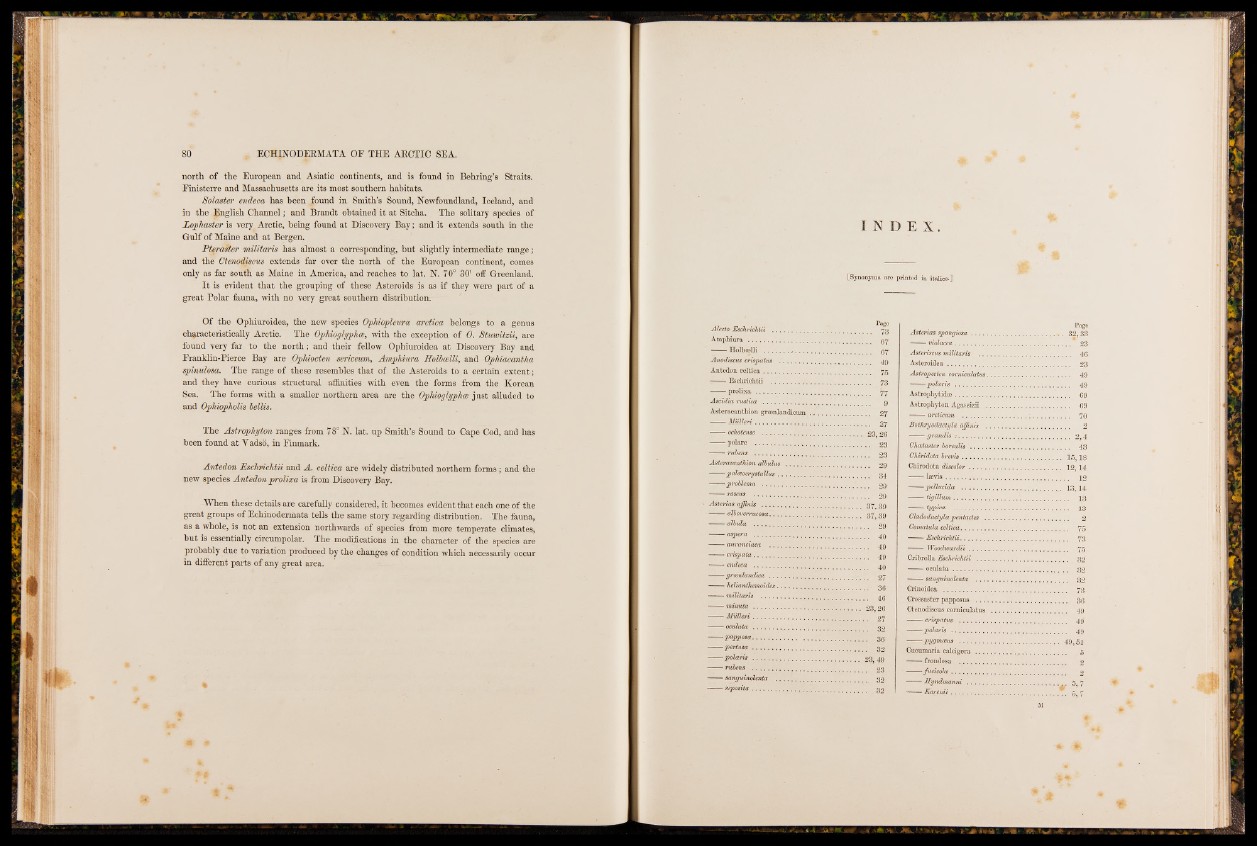
80 ECHINODERMATA OF THE ARCTIC SEA.
north of the European and Asiatic continents, and is found in Behring’s Straits.
Einisterre and Massachusetts are its most southern habitats.
Solaster endeca has been found in Smith’s Sound, Newfoundland, Iceland, and
in the English Channel; and Brandt obtained it at Sitcha. The solitary species of
Jjqphaster is very Arctic, being found at Discovery Bay; and it extends south in the
Gulf of Maine and at Bergen.
Pteraster militaris has almost a corresponding, but slightly intermediate range;
and the Ctenodiscus extends far over the north of the European continent, comes
only as far south as Maine in America, and reaches to lat. N. 70° 30' off Greenland.
I t is evident that the grouping of these Asteroids is as if they were part of a
great Polar fauna, with no very great southern distribution.
Of the Ophiuroidea, the new species Ophiopleura arctica belongs to a genus
characteristically Arctic. The Ophioglyphce, with the exception of 0. Stuwitzii, are
found very far to the north; and their fellow Ophiuroidea at Discovery Bay and
Franklin-Pierce Bay are Ophiocten sericeum, Amphiura Holbcelli, and Ophiacantha
spinulosa. The range of these resembles that of the Asteroids to a certain extent;
and they have curious structural affinities with even the forms from the Korean
Sea. The forms with a smaller northern area are the Ophioglyphce just alluded to
and Ophiopholis lellis.
The Astrophyton ranges from 78° N. lat. up Smith’s Sound to Cape Cod, and has
been found at Vadso, in Finmark.
Antedon Eschrichtii and A. celtica are widely distributed northern forms; and the
new species Antedon prolixa is from Discovery Bay.
When these details are carefully considered, it becomes evident that each one of the
great groups of Echinodermata tells the same story regarding distribution. The fauna,
as a whole, is not an extension northwards of species from more temperate climates,
but is essentially circumpolar. The modifications in the character of the species are
probably due to variation produced by the changes of condition which necessarily occur
in different parts of any great area.
I N D E X
[Synonyma arc printed in italics.]
Alecto Eschrichtii ........................................................ 73
Am p h iu ra ......................................................................... 37
------Holbcelli .............................................. 37
AnodisCus crispatus ........................................................ 49
Antedon c e ltic a .......................................................... 7 5
:------Eschrichtii .............................................................. 73
p r o lix a .................................................................... 7 7
Ascidia rustica .........................................\ ............ 9
Asteracanthion grcenlandicum ............................. 27
------- M u lle n ....................... . , .................................... 07
-------ochotensc ................................................; ............ 23 26
-------polare .............................. 23
—— rubens .................................................................... 23
Asteracanthion albulus ........................... . . . . . . . , 29
-------palceocrystallus.................................... 34
- . - problema ............ '...................................... _ _ 29
-------roseus . ............................................. - 29
Asterias ajjtnis ................................................... 3 7 39
-------alboverrucosa......................................................... 3 7 39
-------albula .............................................................. 29
---- 00$* .................... 40
-------auranciaca ......................................................... 49
-------crispata............................................................ 49
-------endeca ........................... 49
—— grcenlandica ....................................................... 2 7
-------helianthemoides........................................... 3 g
-------militaris .................................................... # 4 g
------r m in u ta ............................... ......................... 23 26
-------M id le r i.............................................................. 2 7
-------o cu la ta ............................................................. 32
-------papposa.................................. 3 g
-------p e r tu s a ................................................. . .............. _ _ 32
-------p o l a r i s .................................................................. 23 49
-------rubens ........................................ 23
-------sanguinolenta ......................................................... 32
-------seposita................................................................... 32
Pago
Asterias spongiosa....................................................... 32 33
-------violacea........................................................................ 23
Asteriscus militaris ........................................................ 46
Asteroidea................................................................. 23
Astropecten comieulatus................................................... 49
-------polaris .................................................................. 49
Astrophytidse.......................... 69
Astrophyton Agassizii ................................................... 69
-------arcticum .........................................; ....................... 70
Bothryodactyla affmis ........................................ 2
-------grandis ...................... ................................................ 2 4
Chcetaster b o rea lis............................... 43
Chiridota brevis............................................................. 1 5 18
Chirodota d iscolor....................................................... 1 2 14
-------lsev is............................................. ............................... 12
-------pellucida ............................................................. 13' 14
— -----tigillum .......................................... 13
------ ty p ic a ........................ ......................... . . . . . . . . 13
Cladodactyla pentactes ........................ 2
Comatula celtica.................................................................. 7 5
-------Eschrichtii................................................................... 73
— ---- Woodwardii ............................................................. 7 5
Cribrella Eschrichtii ........................................................ 32
-------- oculata ....................................................................... 32
-------sanguinolenta .................... 32
Orinoidea ........................................................................... 73
Crossaster papposus ...............! ............................ .. 36
Ctenodiscus comieulatus .............................................. 49
-------crispatus ............. 49'
-------p o la r i s ............................. 49
:— -.pygmeeus ............................. .............................. 4 9 ,51
Cucumaria calcigera ............................... 5
-------frondosa ...................................................................... 2
—— fu c ico la ............................................. 2
—*— Hyndmanni ................ 5 . 7
-------K o ren ii.......................... ............................. .. _ 5 7
4 9M W m5